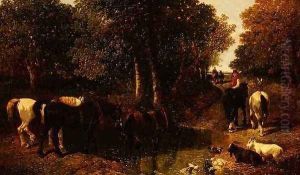J.F.& Lee, F.R. Herring Snr. Paintings
J.F. Herring Sr., also known as John Frederick Herring Sr., was a notable painter of horses, horse-racing, and hunting scenes in the 19th century. Born in London on September 12, 1795, Herring came from humble beginnings and initially worked as a coachman, which provided him with a deep understanding and appreciation of horses. His intimate knowledge of these animals translated into the accuracy and life-like quality of his equine portrayals.
Herring’s artistic talents were recognized early on, and by the 1820s, he began painting inn signs and coach insignias while also starting to produce oil paintings of horses. His work caught the attention of wealthy patrons, which eventually led to commissions to paint horses belonging to the aristocracy. By the 1830s, Herring had become a highly sought-after artist, and his paintings were in great demand.
He moved to Newmarket, the heart of British horse racing, in 1833, which further solidified his career as an equine artist. Herring’s paintings from this period are characterized by their fine detail, accuracy, and the ability to capture the personality and spirit of the horses he depicted. In 1845, he was appointed as the Animal Painter to HRH the Duchess of Kent, followed by a later appointment as Animal Painter to Queen Victoria, which significantly boosted his reputation.
J.F. Herring Sr. continued to work and exhibit his paintings throughout his life. He fathered J.F. Herring Jr., Charles Herring, and Benjamin Herring, who all became artists, with J.F. Herring Jr. also specializing in horse subjects. John Frederick Herring Sr. died on September 23, 1865, leaving behind a rich legacy of equine art that continues to be appreciated by collectors and enthusiasts of horse racing history.
F.R. Lee, known as Frederick Richard Lee, RA, was a 19th-century British artist who specialized in landscapes and was an occasional collaborator with John Frederick Herring Sr. Born in Barnstaple, Devon, on June 7, 1798, Lee was a prominent landscape painter who exhibited at the Royal Academy and other British institutions. He was elected as a full member of the Royal Academy in 1838.
Lee often painted the backgrounds of landscapes in which Herring would later add figures and animals, especially horses, creating a collaborative work that showcased the skills of both artists. This partnership resulted in a number of well-received paintings during the mid-19th century. Lee was known for his naturalistic landscapes, which showed an understanding of light and atmosphere, and were often inspired by the British countryside.
Unlike Herring, Lee was also an accomplished traveler and painted scenes from his ventures to Europe and South Africa. His works exhibit a diverse range of scenery, from the lush English landscapes to the rugged terrains of the Cape Colony. In his later years, Lee focused more on his landscape work, and after a successful career, he retired to Vleesch Bank in South Africa, where he continued to paint.
Frederick Richard Lee died on June 5, 1879, leaving behind a substantial body of work that remains significant for its portrayal of 19th-century landscapes and for his collaborations with Herring, which uniquely combined the genres of equine and landscape painting.
